Architecture Tour Package, Punjab
>> Click for Details & Price QuoteITINERARY:
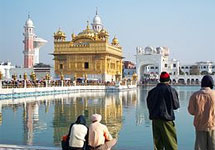
Day 01 - Amritsar
Arrive Amritsar Railway Station. On arrival meet and greet by our representative who will take you to the hotel. Check in hotel. Relax for a while. Overnight stay.
Day 02 - Amritsar
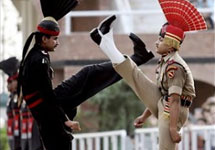 After breakfast. Start your full day city tour with the blessings of Golden Temple-the most important sikh shrine which is also called Mecca for the Sikhs is a living symbol of the spiritual and historical traditions of the Sikhs. The Harimandir Sahib (meaning Temple of God) is also commonly known as the Golden Temple or Darbar Sahib (Divine Court). It is situated in the city of Amritsar in Punjab. The Golden Temple is a living symbol of the spiritual and historical traditions of the Sikhs. It is a source of inspiration for all Sikhs and their chief place of pilgrimage. Sri Akal Takht Sahib :Akal Takht Sahib literally means Eternal Throne. It is also part of the Golden Temple complex in Amritsar. It's foundation was laid by Guru Hargobind Sahib . The Akal Takht is situated opposite to Harmandir Sahib and are connected by a passage. The building of the Akal Takht opposite the Golden Temple has a special meaning. While the Golden Temple stands for spiritual guidance the Akal Takht symbolizes the dispensing of justice and temporal activity. During the day the Guru Granth Sahib is kept in the Golden Temple, while at night it is kept in the Akal Takht Sahib. In earlier days all Sikh warriors sought blessings here before going to battle fields. During the 18th century while Sikhs were fighting a guerrilla war in the forests they used to gather at the Akal Takht on special occasions such as Baisakhi and Diwali. Here the community used to have general meetings and approve resolutions. The Akal Takht is the oldest of the Five Takhts., then visit Jallianwala Bagh- where, on April 13, 1919, British and Gurkha soldiers opened fire on an unarmed forbidden gathering, killing hundreds of civilians. Evening visit Indo-Pak Wagah Border to watch Flag Retreat Ceremony- Wagah, an army outpost on Indo-Pak border 30 Kms from Amritsar where the daily highlight is the evening "Beating the Retreat" ceremony. Soldiers from both countries march in perfect drill, going through the steps of bringing down their respective national flags. As the sun goes down, nationalistic fervour rises and lights are switched on marking the end of the day amidst thunderous applause. Return to hotel. Overnight stay.
After breakfast. Start your full day city tour with the blessings of Golden Temple-the most important sikh shrine which is also called Mecca for the Sikhs is a living symbol of the spiritual and historical traditions of the Sikhs. The Harimandir Sahib (meaning Temple of God) is also commonly known as the Golden Temple or Darbar Sahib (Divine Court). It is situated in the city of Amritsar in Punjab. The Golden Temple is a living symbol of the spiritual and historical traditions of the Sikhs. It is a source of inspiration for all Sikhs and their chief place of pilgrimage. Sri Akal Takht Sahib :Akal Takht Sahib literally means Eternal Throne. It is also part of the Golden Temple complex in Amritsar. It's foundation was laid by Guru Hargobind Sahib . The Akal Takht is situated opposite to Harmandir Sahib and are connected by a passage. The building of the Akal Takht opposite the Golden Temple has a special meaning. While the Golden Temple stands for spiritual guidance the Akal Takht symbolizes the dispensing of justice and temporal activity. During the day the Guru Granth Sahib is kept in the Golden Temple, while at night it is kept in the Akal Takht Sahib. In earlier days all Sikh warriors sought blessings here before going to battle fields. During the 18th century while Sikhs were fighting a guerrilla war in the forests they used to gather at the Akal Takht on special occasions such as Baisakhi and Diwali. Here the community used to have general meetings and approve resolutions. The Akal Takht is the oldest of the Five Takhts., then visit Jallianwala Bagh- where, on April 13, 1919, British and Gurkha soldiers opened fire on an unarmed forbidden gathering, killing hundreds of civilians. Evening visit Indo-Pak Wagah Border to watch Flag Retreat Ceremony- Wagah, an army outpost on Indo-Pak border 30 Kms from Amritsar where the daily highlight is the evening "Beating the Retreat" ceremony. Soldiers from both countries march in perfect drill, going through the steps of bringing down their respective national flags. As the sun goes down, nationalistic fervour rises and lights are switched on marking the end of the day amidst thunderous applause. Return to hotel. Overnight stay.
Day 03-Kapurthala
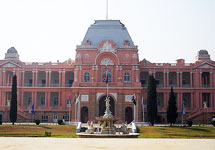 After breakfast drive to Kapurthala visit Jagatjit Palace is a remarkable building situated in Kapurthala in Punjab. It was the erstwhile palace of Maharaja Jagatjit Singh and was modelled after the Versailles Palace. Presently, the Jagatjit Palace is managed by the Defence Ministry and Kapurthala Sainik School functions in this building.Jagatjit Palace is a unique example of French architecture. The painted ceilings and the plaster of Paris figures represent the finest of French art and architecture. The interior decoration of the palace is exquisitely garnished with imported art work from France, Italy and Holland. The Darbar hall of the palace is one of the finest in India. After Lunch visit Moorish Mosque-A spectacular example of the secular history of Kapurthala is the Moorish Mosque, a famous replica of the Grand Mosque of Marakesh, Morocco, was built by a French architect, Monsieur M Manteaux. Its construction was commissioned by the last ruler of Kapurthala, Maharajah Jagatjit Singh and took 13 years to complete between 1917 and 1930. It was then consecrated in the presence of the late Nawab of Bhawalpur. The Mosque's inner dome contains decorations by the artists of the Mayo School of Art, Lahore. The Mosque is a National Monument under the Archeological Survey of India. It was one of the monumental creations in the State during the premiership of late Diwan Sir Abdul Hamid Kt., CIE, OBE. It was his keen interest with Maharaja's blessings that the mosque was completed. Its wooden model lay at the entrance of the Lahore Museum.Overnight stay at Stay at kapurthala.
After breakfast drive to Kapurthala visit Jagatjit Palace is a remarkable building situated in Kapurthala in Punjab. It was the erstwhile palace of Maharaja Jagatjit Singh and was modelled after the Versailles Palace. Presently, the Jagatjit Palace is managed by the Defence Ministry and Kapurthala Sainik School functions in this building.Jagatjit Palace is a unique example of French architecture. The painted ceilings and the plaster of Paris figures represent the finest of French art and architecture. The interior decoration of the palace is exquisitely garnished with imported art work from France, Italy and Holland. The Darbar hall of the palace is one of the finest in India. After Lunch visit Moorish Mosque-A spectacular example of the secular history of Kapurthala is the Moorish Mosque, a famous replica of the Grand Mosque of Marakesh, Morocco, was built by a French architect, Monsieur M Manteaux. Its construction was commissioned by the last ruler of Kapurthala, Maharajah Jagatjit Singh and took 13 years to complete between 1917 and 1930. It was then consecrated in the presence of the late Nawab of Bhawalpur. The Mosque's inner dome contains decorations by the artists of the Mayo School of Art, Lahore. The Mosque is a National Monument under the Archeological Survey of India. It was one of the monumental creations in the State during the premiership of late Diwan Sir Abdul Hamid Kt., CIE, OBE. It was his keen interest with Maharaja's blessings that the mosque was completed. Its wooden model lay at the entrance of the Lahore Museum.Overnight stay at Stay at kapurthala.
Day 04-Jalandhar
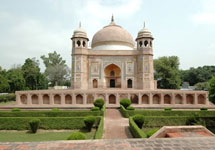 After breakfast at hotel, drive to nakodar visit Tomb of Haji Jamal is close to the tomb of Muhammed Momin. This tomb was raised over the mortal remains of Haji Jamal, a pupil of Ustad Muhammed Husseini, the tambura player, towards the close of Emperor Shah Jahan’s regin. The two lined inscription engraved on the entrance gate of the tomb refers to its bing the tomb of Haji Jamal and gives a date of AH 1067 ( AD 1657). It stands in the middle of the square platform, panelled on all sides with deep recesses concealing two flight of steps on each side. Each of the four faces have octagonal recesses covered by pointed archs. The southern one gives access to the burial chamber while the remaining ones are closed with pierced tracery screens. Its inner chamber is octagonal where as the outer plan is square having octagonal turrets surmounted with domed cupolas added to the corners. A bulbous dome crowned with pinnacle sits over a high drum and is balanced by the four cupolas crowning the turrets at the cornor. The façade is divided into red stucco covered brick framed panels and painted with white lines. The larger panels are filled with flower pots and the smaller with geometrical designs. The broad belts between the panels are ornamented with diper designs in tiles of different colours. The octagonal towers and the battlements as well as the pinnacles of the domes are ornamented with glazed tiles. Overnight stay at jalandhar.
After breakfast at hotel, drive to nakodar visit Tomb of Haji Jamal is close to the tomb of Muhammed Momin. This tomb was raised over the mortal remains of Haji Jamal, a pupil of Ustad Muhammed Husseini, the tambura player, towards the close of Emperor Shah Jahan’s regin. The two lined inscription engraved on the entrance gate of the tomb refers to its bing the tomb of Haji Jamal and gives a date of AH 1067 ( AD 1657). It stands in the middle of the square platform, panelled on all sides with deep recesses concealing two flight of steps on each side. Each of the four faces have octagonal recesses covered by pointed archs. The southern one gives access to the burial chamber while the remaining ones are closed with pierced tracery screens. Its inner chamber is octagonal where as the outer plan is square having octagonal turrets surmounted with domed cupolas added to the corners. A bulbous dome crowned with pinnacle sits over a high drum and is balanced by the four cupolas crowning the turrets at the cornor. The façade is divided into red stucco covered brick framed panels and painted with white lines. The larger panels are filled with flower pots and the smaller with geometrical designs. The broad belts between the panels are ornamented with diper designs in tiles of different colours. The octagonal towers and the battlements as well as the pinnacles of the domes are ornamented with glazed tiles. Overnight stay at jalandhar.
Day 05-Patiala
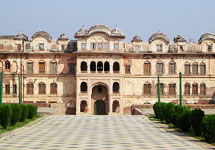 After breakfast drive to Patiala is the erstwhile princely state of Punjab, which is situated in malwa region.Visit Bhadurgarh Fort 6 kms from Patiala, initially founded by Nawab Saif Khan in 1658. The present fort was built by Maharaja Karam Singh of Patiala in 1837. It has two circular ramparts and is surrounded by a moat and covers an area of 2100 sq meters. This rather compact but nicely designed citadil is in the custody of the Department of police.The four wails of the fort enclose the village Saifabad located on the left-side of the Rajpura-Patiala Road. Saif Khan, a relative of the Mughal Emperor Aurangzeb, after holding several important offices, became a hermit and settled down here. After his death he was buried here. His tomb behind the fort, a structure of 177 x 177 ft. is in a state of neglect. Notwithstanding this, his followers still lit a lamp on the tomb every Thursday. Sheesh Mahal Patiala The Sheesh Mahal is the famous tourist place in Patiala. Maharaja Narinder Singh built this Mahal in 1847. The design and the decoration of the palace was chosen by Maharaja Narinder Singh to a large extent. One section of Sheesh Mahal is decorated with colored glass and mirror work and it is also known as ‘Palace of Mirrors’. It is situated behind the Moti Bagh Palace. It is a triple storey building. There is a bridge across the artificial lake in the centre of the palace. This bridge is known as Lakshman Jhoola. There are gardens and fountains on the sides of the lake. Sheesh Mahal was the residential palace of Maharajas of Patiala. To give the artistic look on the walls and ceilings of the Sheesh Mahal, Maharaja Narinder Singh engaged artistic painters from Rajasthan and Kangra. The artist made the floral designs on the walls and ceilings. Their art depict the vision of Bihari, Surdas and Keshav in the poetic form and in colors. Moti Bagh Palace, is a palace in Patiala, and was built as one of the largest residences in the world and served as principal residence for Patiala royal family till late 40' when it shifted to New Motibagh Palace which acts as permanent residence to Maharaja of Patiala and his family. The old quarters were built in 1840s by Maharaja of Patiala, and was expanded in 1920s during the reign of Maharaja Bhupinder Singh. After independence Maharaja Yadavindra Singh donated it to Government of India which later converted a part of it into a museum, a taxidermy gallery, and North Zone Cultural Centre.
After breakfast drive to Patiala is the erstwhile princely state of Punjab, which is situated in malwa region.Visit Bhadurgarh Fort 6 kms from Patiala, initially founded by Nawab Saif Khan in 1658. The present fort was built by Maharaja Karam Singh of Patiala in 1837. It has two circular ramparts and is surrounded by a moat and covers an area of 2100 sq meters. This rather compact but nicely designed citadil is in the custody of the Department of police.The four wails of the fort enclose the village Saifabad located on the left-side of the Rajpura-Patiala Road. Saif Khan, a relative of the Mughal Emperor Aurangzeb, after holding several important offices, became a hermit and settled down here. After his death he was buried here. His tomb behind the fort, a structure of 177 x 177 ft. is in a state of neglect. Notwithstanding this, his followers still lit a lamp on the tomb every Thursday. Sheesh Mahal Patiala The Sheesh Mahal is the famous tourist place in Patiala. Maharaja Narinder Singh built this Mahal in 1847. The design and the decoration of the palace was chosen by Maharaja Narinder Singh to a large extent. One section of Sheesh Mahal is decorated with colored glass and mirror work and it is also known as ‘Palace of Mirrors’. It is situated behind the Moti Bagh Palace. It is a triple storey building. There is a bridge across the artificial lake in the centre of the palace. This bridge is known as Lakshman Jhoola. There are gardens and fountains on the sides of the lake. Sheesh Mahal was the residential palace of Maharajas of Patiala. To give the artistic look on the walls and ceilings of the Sheesh Mahal, Maharaja Narinder Singh engaged artistic painters from Rajasthan and Kangra. The artist made the floral designs on the walls and ceilings. Their art depict the vision of Bihari, Surdas and Keshav in the poetic form and in colors. Moti Bagh Palace, is a palace in Patiala, and was built as one of the largest residences in the world and served as principal residence for Patiala royal family till late 40' when it shifted to New Motibagh Palace which acts as permanent residence to Maharaja of Patiala and his family. The old quarters were built in 1840s by Maharaja of Patiala, and was expanded in 1920s during the reign of Maharaja Bhupinder Singh. After independence Maharaja Yadavindra Singh donated it to Government of India which later converted a part of it into a museum, a taxidermy gallery, and North Zone Cultural Centre.
Day 06-Chandigarh
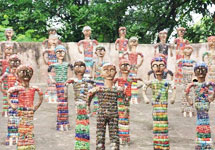 After breakfast drive to Chandigarh on arrival check inn hotel. Le Corbusier Centre, Chandigarh Architect 'Le Corbusier' does not need an introduction. He is more popularly known as the PLANNER of Chandigarh among Architects.Le Corbusier designed and constructed buildings throughout Europe, India and in North and South America. He was an urban planner, painter, sculptor, writer and modern furniture designer.Some six decades ago, this legendary man was working from a office situated in Sector-19 in Chandigarh and was designing the whole city which was also designed by him. The same old office complex is now converted to 'Le Corbusier Centre' and is the SIXTH one all over the world dedicated to him This building is designed in such a manner that the temperature inside the rooms does not go beyond 35 degrees Celsius in summers and does not go below 10 degrees Celsius in winters. So there is no need of any air conditioner or any artificial light here.
After breakfast drive to Chandigarh on arrival check inn hotel. Le Corbusier Centre, Chandigarh Architect 'Le Corbusier' does not need an introduction. He is more popularly known as the PLANNER of Chandigarh among Architects.Le Corbusier designed and constructed buildings throughout Europe, India and in North and South America. He was an urban planner, painter, sculptor, writer and modern furniture designer.Some six decades ago, this legendary man was working from a office situated in Sector-19 in Chandigarh and was designing the whole city which was also designed by him. The same old office complex is now converted to 'Le Corbusier Centre' and is the SIXTH one all over the world dedicated to him This building is designed in such a manner that the temperature inside the rooms does not go beyond 35 degrees Celsius in summers and does not go below 10 degrees Celsius in winters. So there is no need of any air conditioner or any artificial light here.
The main aim of the Centre is preservation, interpretation, research, display of the works and legacy of Le Corbusier. The centre is divided into six sections portraying the archival records, original plans, elevations, sketches and studies, maps and models, documents, photographs and furniture. Three rooms are serving as reception, reference and digital library with internet facility.Later visit The Open Hand
One of the most significant planned by Le Corbusier in Chandigarh is the Open Hand. The monument is a place to visit in Chandigarh. Rising 85 feet high from a sunken trench, a giant hand in metal sheets is designed to rotate "like a weather cock, not to show the incertitude of ideas, but to indicate symbolically the direction of wind (that is the state of affairs)." It is also meant to convey a message of peace "open to receive." Amongst the other monumental places to visit in Chandigarh are the Tower of Shadows, Geometric Hill, and Martyr's Memorial.
Day 07-Chandigarh
Then visit an embodiment of imagination and novelty, the Rock garden in Chandigarh is a rare scenario, which cannot be equated with anything else. Only one of its kind, the garden is put up with the urban and industrial wastes. Rock Garden is spread over an expanse of 64 acers. It displayed various sculptures made up of broken ken glass bangles, china ware, discarded fluorescent tubes, clay and coal. Walls of terracotta pots and the maze of paths, canyons and chambers proffer the glance of a dream world .The fantastic 14 chambers with a waterfall puddles, statues of animals, birds this garden helps one to stretch one imagination. The builds in the garden prove high similitude to Mughal ethnicity. Later drive to Bhathinda visit Qila Mubarak is a historical monument in the heart of the city of Bathinda in India. It has been in existence from 90-110 AD in its current place. It was here that Razia Sultan, the first woman to take charge of the Delhi throne was incarcerated on her defeat and dethroned. The bricks of the fort date back to the Kushana period when emperor Kanishka ruled over Northern India/Bactria. Raja Dab, along with emperor Kanishka, is believed to have built the fort. Overnight stay at Bhathinda.
Day 08- Departure
After breakfast drive to Chandigarh transfer you to Railway Station/Airport for your onward journey.
Tour Packages
- North India Agriculture Tour9 Nights / 10 Days
- Amritsar 1 Day Sightseeing TourAC Car, Mineral Water, Veg. Lunch (Punjabi Thali)
- Amritsar Village Day TripTractor Ride, Veg.Lunch, Farming, Interact Villager.
- Delhi to Amritsar Darshan with Village Trip3 Days
- Amritsar City with Village Tour1 Nights / 2 Days
- Amritsar Day Trip with Village Tour
- Amritsar Day Trip with Sada Pind Cultural Show
- Amritsar, Punjab, Kurukshetra, Chandigarh
- Delhi, Punjab, Delhi 7 Days
- Hola Mohalla Festival3 Nights / 4 Days
- Punjab Educational Tour Package4 Nights / 5 Days
- Punjab Culture and Heritage Tour4 Nights / 5 Days
- Punjab Architecture Tour Package7 Nights / 8 Days
- Punjab Nature and Eco Tour Package4 Nights / 5 Days
- Punjab Forts and Monuments Tour10 Nights / 11 Days
- Punjab Volunteers Tour Package4 Nights / 5 Days
- 5 Sarovar Darshan Tour Package1 Night / 2 Days
- Punjab Tour Package5 Nights / 6 Days
- Heritage Walk in Amritsar Tour Package2 Nights / 3 Days
- Punjab Gurudwara Darshan Tour7 Nights / 8 Days
- Golden Temple with Buddhist Tour4 Nights / 5 Days
- Honeymoon Paradise Punjab Tour4 Nights / 5 Days
- Amritsar with Kartarpur Sahib Tour2 Nights / 3 Days
- Kila Raipur Sports Festival Package5 Nights / 6 Days
- Punjab Cooking with Homestay Package1 N / 2 D
- Delhi with Punjab Tour Package7 N / 8 D
- Chandigarh Amritsar Tour Package4 N / 5 D
- Amritsar Dalhousie Shimla Chandigarh Tour Package 6 Nights / 7 Days
- Amritsar Village with Jalandhar Tour Package 2 Nights / 3 Day
- Punjab with Himachal Tour Package 15 Nights / 16 Days
- Amritsar, Anandpur, Manikaran Sahib Gurudwara Tour 5 Nights / 6 Days
Short Tour Packages
- Amritsar Short Tour1 Day Sightseeing
- Chandigarh Short Tour1 Day Sightseeing
- Ludhiana Short Tour1 Day Sightseeing
- Jalandhar Short Tour1 Day Sightseeing
- Kapurthala Short Tour1 Day Sightseeing
- Patiala Short Tour1 Day Sightseeing
- Bathinda Short Tour1 Day Sightseeing
- Gurdaspur Short Tour1 Day Sightseeing
- Faridkot Short Tour1 Day Sightseeing
- Ferozepur Short Tour1 Day Sightseeing
- Muktsar Short Tour1 Day Sightseeing
- Rupnagar Short Tour1 Day Sightseeing
- Sangrur Short Tour1 Day Sightseeing
- Moga Short Tour1 Day Sightseeing
Main Links
Travel Information
Exploring Punjab - Vacations
Punjab's Forestry and Wildlife
The Unique eco-system of the Shivaliks is spread over a geographical area 9448.97 Sq. km, and lies in the north-eatern part of the state extending from north-west to south-east along the Himachal Pradesh Border. It is spread across the eastern part of the districts of Gurdaspur, Hoshiarpur, Shaheed Bhagat Singh Nagar and Rupnagar


